Here’s Why Text to Order Is the Next Big Thing in E-Commerce
The number of direct-to-consumer (DTC) brands investing in text to buy shows us what the future of e-commerce looks like. Here’s why.

The number of direct-to-consumer (DTC) brands investing in text to buy shows us what the future of e-commerce looks like. Here’s why.

If you’re like most e-commerce retailers, you get more traffic from mobile devices than desktop. Take this example from Schuh.
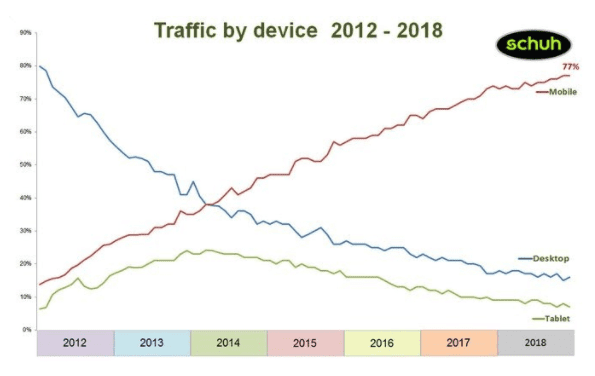
According to SaleCycle’s client data from 2019, 63% of traffic to retailers, and 53% of sales happen via mobile.
There’s no denying the dominance of mobile. In response, marketers now focus more on their mobile marketing. They might apply a mobile-first design approach to their website. Or, if they have deep pockets, create a mobile app.
There’s nothing wrong with those approaches. But websites and apps create “friction points” when someone goes to buy: they need to input payment information and their address, and then create or remember their account’s login details.
It’s why we write about abandoned carts so often.
What e-commerce companies need is a way to make buying from a mobile device so easy that it’s completely effortless.
That’s where “text to order” or, as it’s also known, “text to buy” comes in.
Text to buy comes in different forms. Some companies send out exclusive offers, and you respond with the quantity you want. Others allow you to send a text message with what you want and when you want it.
Both point to a future where e-commerce is conversation-based, and customers don’t need to download an app or log into a website to make a purchase.
The “text to get” model also removes the need for a traditional mobile checkout, which can be clumsy and a time drain. Finally, sending a text message fosters a more personal connection and allows brands to interact with their customers in their language.
The results from brands that currently use text to order are even more exciting. In March, the canned wine brand Bev launched its “Text to Order” option throughout its home market of Los Angeles County.
The influx of text orders helped Bev see a 1000% growth in online orders in the first quarter, with roughly 350% attributed directly to text-to-order. Another alcohol brand, Loverboy, saw 1,500 customers ordering a newly launched product in 24 hours.
As we mentioned, there are two approaches to text to buy that we’ve seen brands implement. The first involves a more automated approach where a company sends out exclusive offers, and a customer responds with the quantity they’d like.
Our customer, LunkerText, applies this approach. (They created this automated flow using our SMS API.)
You sign up for the service by providing your email, phone number, address, apparel sizes, and billing details. You get a daily deal and can then respond with the number of units you’d like.
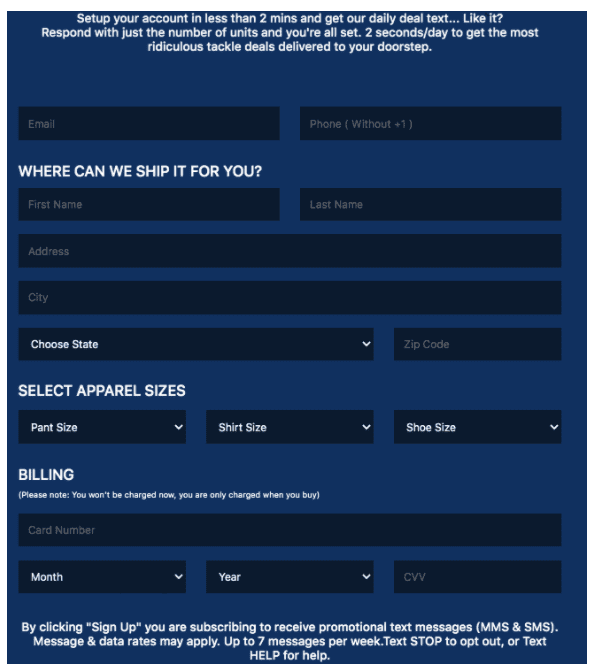
Once someone signs up, they send customers daily offers like this with a call to action to respond with the number of units.
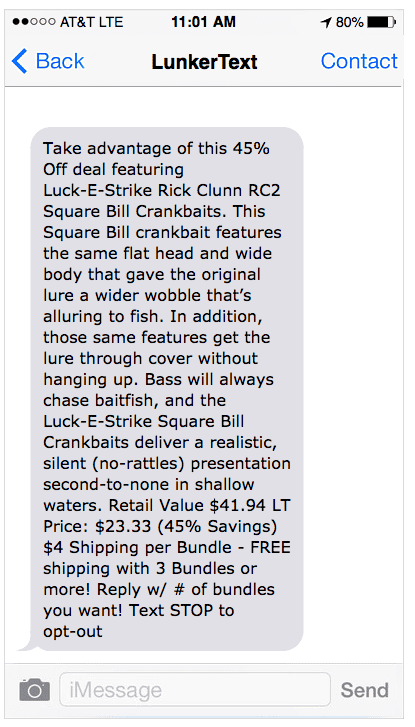
If someone responds with a non-numerical value, they immediately receive a response that lets them know that the system doesn’t understand their message.
If the credit card on file is no longer valid, it also generates an automated text with a link to update the customer’s card details.
WineText.com is another example of a brand that accepts orders by text. (It also happens to be a company run by the world-renowned marketer Gary Vaynerchuk.)
The Wine Text team sends out a daily deal on a bottle of wine at a steeply discounted price. If you like what you see, you respond to the text with how many bottles you want, and you’re done.
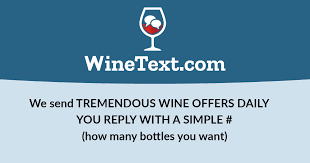
Dirty Lemon represents the second, more conversational approach to text to order, although it offers a more traditional e-commerce experience for first-time buyers.
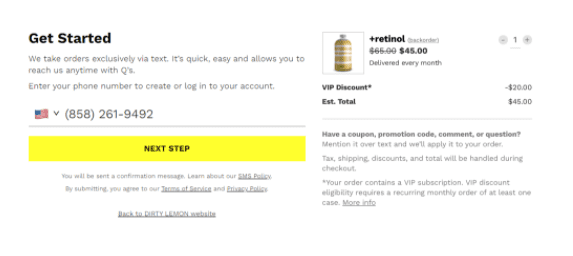
From there, you fill out a contact form that is similar to LunkerText’s.
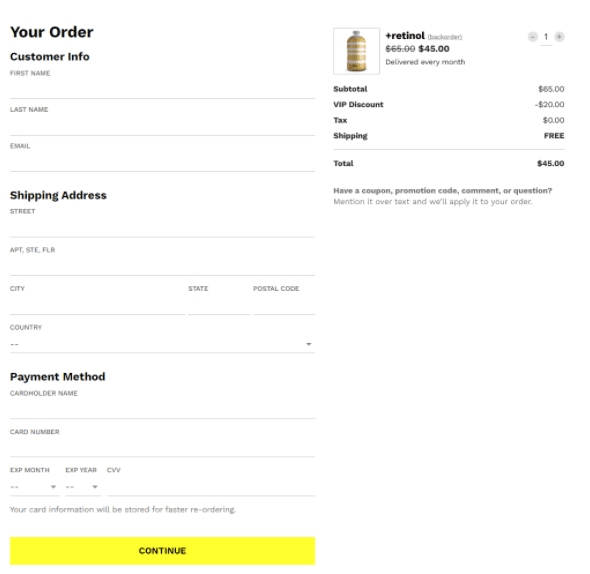
Once you’ve made your first purchase, the DTC retailer encourages customers to ask customer service-style questions and place future orders.
The results are impressive: Dirty Lemon’s customer base has grown to 30,000 customers in the past year, processing 50,000 text messages a month, with millions of dollars transacting through their SMS ordering process.
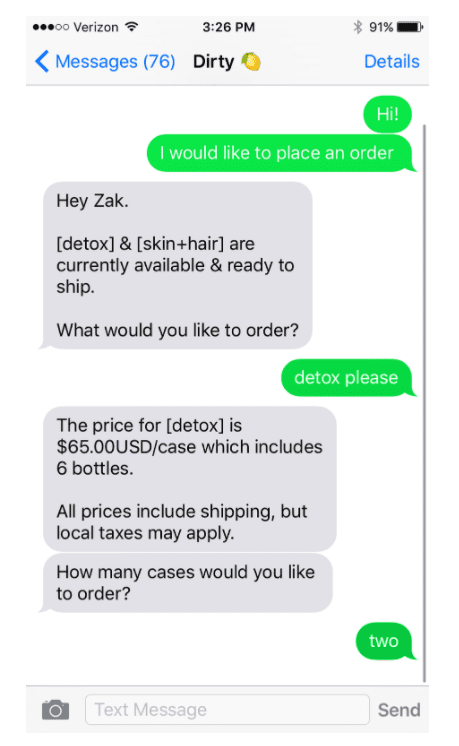
For years e-commerce brands have been fighting the good fight against inconveniences like slow websites and clunky checkout experiences.
While this work has not been in vain, there’s nothing quite as seamless as shooting off a text with a number to buy something you want.
Ordering via text message offers a way to both improve customer satisfaction and grow your business. Everything points to it being the next big thing in DTC marketing.
P.S. Here are some other ways brands are using direct-to-consumer text messages.
Drew Wilkinson is the Head of Marketing at SimpleTexting. Drew has more than a decade of experience managing successful integrated marketing programs to build brands, raise awareness, and generate demand.
More Posts from Drew WilkinsonAubrey’s Bead Closet has a loyal fanbase known as the “ABC family”. Learn more about how this e-commerce store uses SMS to communicate with its fans, launch new products, and drive mobile purchases.
ReadUse this seven-minute read to get savvy and take action with nine must-have e-marketing techniques in e-commerce.
ReadStart a text marketing campaign or have a 1-on-1 conversation today. It's risk free. Sign up for a free 14-day trial today to see SimpleTexting in action.
No credit card required